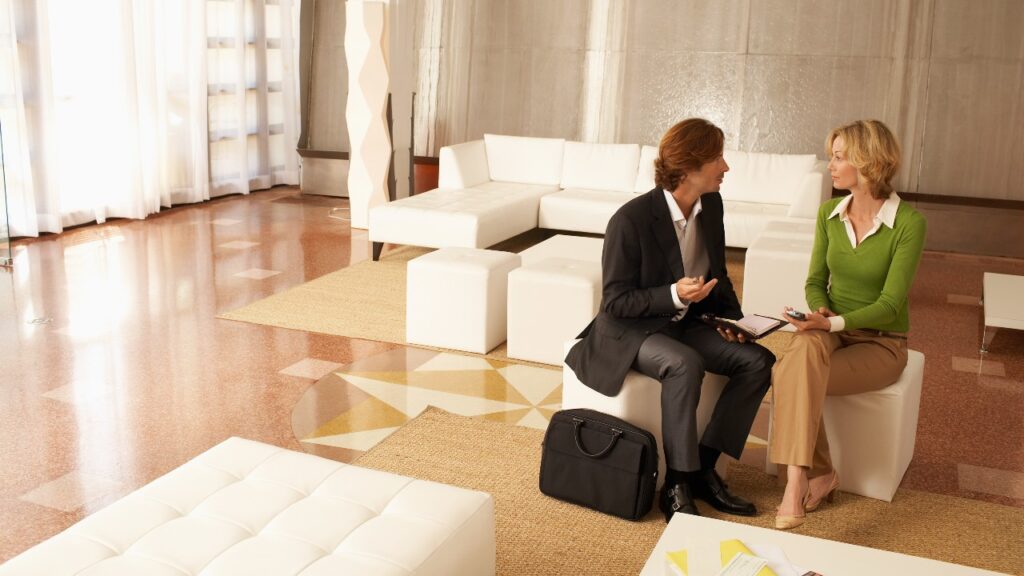Many businesses are forced to rethink office space due to the pandemic, including flooring. When selecting office flooring materials, both form and function should be considered. And, because each room has a particular function, one flooring material will almost likely not work for your entire company—what works in the lobby will almost surely not work in the office kitchen.
Going room by room and selecting materials that complement the function of each space, in a way that aligns with your design tastes and fits your budget limits, is the ideal method to choose office flooring choices.
Reception and Lobby Areas

When choosing a flooring material for your office’s foyer, durability and design are important factors to consider. Customers, stakeholders, vendors, and new staff will notice the lobby first.
As a result, the flooring in your greeting area must offer a positive first impression. It also needs to be able to sustain a lot of foot traffic without seeming worn out. Here are a few materials that are both long-lasting and attractive enough to use in your lobby:
- Wood finishes
- LVT (Luxury Vinyl Tile)
- Terrazzo
Break Rooms and Open Office Areas
The flooring in your office area must fit the desired look of your facility, absorb excess background noise, and sustain high levels of foot activity.
It should blend in with the rest of your facility’s architecture, and its upkeep costs should be within your budget. In ordinary office environments, durable, easy-to-maintain materials are excellent. Here are a couple of products that might be appropriate for use in a regular office setting:
- LVT
- Carpet
Conference Rooms
Important talks with potential employees, clients, and stakeholders take place in conference rooms. As a result, in conference rooms, design is critical—your flooring must make a positive first impression and complement the room’s overall design approach.
While durability should always be taken into account when choosing flooring, it is less of an issue in conference rooms because they see less foot activity than the rest of your workplace. Your primary priority should be design. Here are a couple of products that might be appropriate for use in a regular office setting:
- LVT
- Luxury carpet
- Wood finishes
Kitchen

When choosing flooring for your office kitchen, slip, spill and water-resistance should be your top priorities. Because spills are prevalent and cleanliness is a necessary in food preparation areas, kitchen flooring must be easy to clean, maintain, and repair. Here are a few materials that would be appropriate for your kitchen:
- Linoleum
- LVT
- Quarry tile
The suggestions above are only a handful of the best-fit possibilities for each area; the materials you can use are nearly endless. Your contractor will be able to give you advice on the appropriate flooring material for each section of your business based on your design and budget.
Top Five Choices for Office Flooring
Now that you have a better idea of which flooring options might work in each office area, you should consider which materials best suit your design tastes and budget.
Terrazzo

Terrazzo is a seamless flooring product that is renowned for its durability and design flexibility.
Offering nearly infinite design and colour possibilities, terrazzo flooring is ideal for businesses who wish to greet guests with a custom logo or a distinctive pattern that looks like high-end marble tile.
Terrazzo has a long life expectancy since it is simple to clean and maintain. Terrazzo can last for decades if properly built and maintained.
Wood Finishes
Commercial wood flooring, such as solid hardwood, engineered hardwood, and locking hardwood floors, provide a sophisticated appearance that is ideal for impressing visitors in lobbies and conference rooms.
Although real hardwood is more expensive than its synthetic alternatives, it has a timeless aesthetic that works well in particular design trends. Engineered hardwood is a greener alternative to natural hardwood flooring that has almost the same durability and aesthetic appeal.
Luxury Vinyl Tile (LVT)
Vinyl tile, especially luxury vinyl tile (LVT), is an excellent choice for office environments. LVT is extremely long-lasting, low-maintenance, and adaptable. It blends easily into almost any design scheme, making it a perfect choice for practically every space in your office, thanks to a vast range of finishes and design possibilities.
Carpet
Where sound absorption and longevity are important, such as in open-office areas and common rooms, both broadloom carpet and carpet tiles are excellent choices.
Carpet is attractive, environmentally beneficial, and long-lasting. Broadloom carpet is less expensive up front, but it is more difficult to maintain than carpet tile.
Quarry Tile
For decades, quarry tile has been the industry standard for commercial kitchens. It has a high lifetime value since quarry tile is both inexpensive to install and naturally durable. Quarry tile is simple to clean and maintain, and it can tolerate spills and heavy foot activity that are frequent in kitchens.
Office flooring materials should be chosen based on the room, function, design preferences, and, of course, cost. When it comes to installation and maintenance costs, a flooring contractor should be able to steer you toward materials that not only meet those standards, but also provide the highest lifetime value.
Check out our paper shredding tips as well as our guide on choosing the best security camera for your business.
Leave a Reply